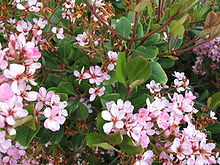Rhaphiolepis
| Rhaphiolepis | |
|---|---|

| |
| Rhaphiolepis indicain flower | |
| Scientific classification | |
| Kingdom: | Plantae |
| Clade: | Tracheophytes |
| Clade: | Angiosperms |
| Clade: | Eudicots |
| Clade: | Rosids |
| Order: | Rosales |
| Family: | Rosaceae |
| Subfamily: | Amygdaloideae |
| Tribe: | Maleae |
| Subtribe: | Malinae |
| Genus: | Rhaphiolepis Lindl. |
| Species | |
|
see text | |
| Synonyms[1] | |
| |
Rhaphiolepis(/ˌræfiˈɒlɪpɪs/RAF-ee-OL-ip-issor/ˌræfioʊˈlɛpɪs/RAF-ee-oh-LEP-iss)[2]is a genus of about fifteen species ofevergreenshrubsand smalltreesin the familyRosaceae,native to warm temperate and subtropicalEast AsiaandSoutheast Asia,from southernJapan,southernKoreaand southernChina,south toThailandandVietnam.In searching literature it is well to remember that the name commonly is misspelt "Raphiolepsis ". The genus is closely related toEriobotrya(loquats), so closely in fact, that members of the two genera have hybridised with each other; for example× Rhaphiobotrya,the "Coppertone loquat", is a hybrid ofEriobotrya deflexaXRhaphiolepis indica.The common namehawthorn,originally specifically applied to the related genusCrataegus,now also appears in the common names for someRhaphiolepisspecies. For example,Rhaphiolepis indicaoften is called "Indian hawthorn", andRhaphiolepis umbellata,"Yeddo hawthorn".
Description
[edit]
The species vary in size, some only reaching 1–1.5 m (3 ft 3 in – 4 ft 11 in), whileR. ferrugineacan reach 10 m (33 ft). Theleavesare alternate, leathery, glossy dark green, simple,3–9 cm (1–3+1⁄2in) long, with an entire or serrated margin. Theflowersare white or pink,1–2 cm (1⁄2–3⁄4in) diameter, produced in small to largecorymbswithpaniclestructure. Thefruitis a smallpome1–2 cm (1⁄2–3⁄4in) diameter, ripening dark purple to black, usually containing only a singleseed.
Taxonomy
[edit]Rhaphiolepisis closely related to loquats and toyon and is in the apple subtribe along with many other commercially important fruit like pears. Recent phylogenetic research has suggestedRhaphiolepisandEriobotrya(loquats) be merged.[3]Plants of the World OnlinetreatsEriobotryaas a synonym ofRhaphiolepis.[4]
Research suggests the following phylogenetic relationships:[5]
| 7 species | |||||||||||||||||||
| |||||||||||||||||||
| 117 |
Cultivation and uses
[edit]The best known species isRhaphiolepis indica(Indian hawthorn) from southern China, grown for its decorative pinkflowers,and popular inbonsaiculture.Rhaphiolepis umbellata(Yeddo hawthorn) from Japan and Korea has blunter leaves and white flowers. It is the hardiest species, tolerating temperatures down to about −15 °C (5 °F).[citation needed]
The fruit of some varieties is edible when cooked, and can be used to makejam,but some ornamental varieties bear fruit that is of no culinary value.[citation needed]
Indian Hawthorn is a mainstay horticultural specimen in southern United States. It is often found in commercial as well as in private landscapes. Often it is trimmed into small compact hedges or balls for foundation plants. It has been successfully pruned into a standard form as well as small dwarf-like trees up to 4.5 m (15 ft) in height.
The use ofRhaphiolepisin landscapes in humid regions is limited by the susceptibility of many of its species and hybrids to a disfiguringleaf spotdisease caused by fungi in the genusEntomosporium.
Species
[edit]45 species are currently recognized, according toPlants of the World Online.These include species formerly classed asEriobotrya.[1]
- Rhaphiolepis angustissima(Hook.f.) B.B.Liu & J.Wen
- Rhaphiolepis balgooyi(K.M.Wong & Ent) B.B.Liu & J.Wen
- Rhaphiolepis bengalensis(Roxb.) B.B.Liu & J.Wen
- Rhaphiolepis bibas(Lour.) Galasso & Banfi– loquat
- Rhaphiolepis brevipetiolataJ.E.Vidal
- Rhaphiolepis cavaleriei(H.Lév.) B.B.Liu & J.Wen
- Rhaphiolepis condaoensis(X.F.Gao, Idrees & T.V.Do) B.B.Liu & J.Wen
- Rhaphiolepis × daduheensis(H.Z.Zhang ex W.B.Liao, Q.Fan & M.Y.Ding) B.B.Liu & J.Wen
- Rhaphiolepis deflexa(Hemsl.) B.B.Liu & J.Wen– bronze loquat
- Rhaphiolepis dubia(Lindl.) B.B.Liu & J.Wen
- Rhaphiolepis elliptica(Lindl.) B.B.Liu & J.Wen
- Rhaphiolepis ferrugineaF.P.Metcalf
- Rhaphiolepis fulvicoma(Chun ex W.B.Liao, F.F.Li & D.F.Cui) B.B.Liu & J.Wen
- Rhaphiolepis glabrescens(J.E.Vidal) B.B.Liu & J.Wen
- Rhaphiolepis henryi(Nakai) B.B.Liu & J.Wen
- Rhaphiolepis hookeriana(Decne.) B.B.Liu & J.Wen
- Rhaphiolepis indica(L.) Lindl.– Indian hawthorn
- Rhaphiolepis integerrimaHook. & Arn.
- Rhaphiolepis jiulongjiangensisP.C.Huang & K.M.Li
- Rhaphiolepis lanceolataHu
- Rhaphiolepis laoshanica(W.B.Liao, Q.Fan & S.F.Chen) B.B.Liu & J.Wen
- Rhaphiolepis latifolia(Hook.f.) B.B.Liu & J.Wen
- Rhaphiolepis longifolia(Decne.) B.B.Liu & J.Wen
- Rhaphiolepis macrocarpa(Kurz) B.B.Liu & J.Wen
- Rhaphiolepis majorCardot
- Rhaphiolepis malipoensis(K.C.Kuan) B.B.Liu & J.Wen
- Rhaphiolepis merguiensis(J.E.Vidal) B.B.Liu & J.Wen
- Rhaphiolepis oblongifolia(Merr. & Rolfe) B.B.Liu & J.Wen
- Rhaphiolepis obovata(W.W.Sm.) B.B.Liu & J.Wen
- Rhaphiolepis petiolata(Hook.f.) B.B.Liu & J.Wen
- Rhaphiolepis philippinensis(S.Vidal) Kalkman
- Rhaphiolepis platyphylla(Merr.) B.B.Liu & J.Wen
- Rhaphiolepis poilanei(J.E.Vidal) B.B.Liu & J.Wen
- Rhaphiolepis prinoides(Rehder & E.H.Wilson) B.B.Liu & J.Wen
- Rhaphiolepis salicifoliaLindl.
- Rhaphiolepis salwinensis(Hand.-Mazz.) B.B.Liu & J.Wen
- Rhaphiolepis seguinii(H.Lév.) B.B.Liu & J.Wen
- Rhaphiolepis serrata(J.E.Vidal) B.B.Liu & J.Wen
- Rhaphiolepis stipularis(Craib) B.B.Liu & J.Wen
- Rhaphiolepis tengyuehensis(W.W.Sm.) B.B.Liu & J.Wen
- Rhaphiolepis umbellata(Thunb.) Makino– Yeddo hawthorn
- Rhaphiolepis williamtelliana(Champ. ex Benth.) B.B.Liu & J.Wen
- Rhaphiolepis wuzhishanensisW.B.Liao, R.H.Miau & Q.Fan
Gallery
[edit]-
Thirty-year-old Indian hawthorn that has been pruned into a multi-trunked dwarf-like tree
-
Indian hawthorn fruits
-
Yeddo-Hawthorn tree atBrooklyn Botanic GardeninNew York City
References
[edit]- ^abRhaphiolepisLindl.Plants of the World Online.Accessed 16 December 2023.
- ^The first pronunciation is that expected forAnglo-Latin;the second is common in nurseries.Sunset Western Garden Book,1995:606–607. However,William T. Stearnin his bookBotanical Latinsays "Botanical Latin is essentially a written language, but the scientific names of plants often occur in speech. How they are pronounced really matters little provided they sound pleasant and are understood..."
- ^Liu; Liu; Hong; Wen (2020)."EriobotryaBelongs toRhaphiolepis(Maleae, Rosaceae): Evidence From Chloroplast Genome and Nuclear Ribosomal DNA Data ".Frontiers in Plant Science.10:1731.doi:10.3389/fpls.2019.01731.PMC7019104.PMID32117331.
- ^EriobotryaLindl.Plants of the World Online.Accessed 29 March 2023.
- ^Redelings; Holder (2017)."A supertree pipeline for summarizing phylogenetic and taxonomic information for millions of species".PeerJ.5:e3058.doi:10.7717/peerj.3058.PMC5335690.PMID28265520.



